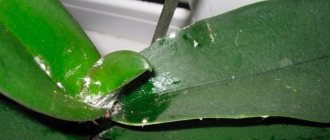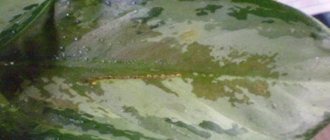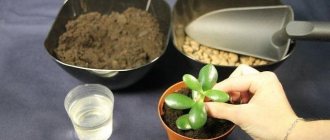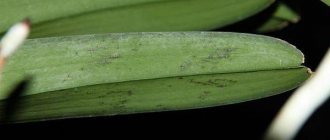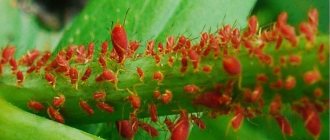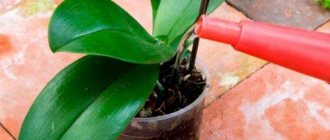When choosing an orchid in a store, flower lovers often look only at the condition of its leaves, flowers and stem. But it is also important to carefully check the soil. It is in the soil that plant pests usually settle, which include: various bugs, white larvae, insects with wings, aphids, spider mites, and scale insects. The negative consequences of the life of parasites on orchids are various - from suppression of growth to absolute death. If the color of the leaves has changed to yellow, and they have begun to wither and curl, or they are shrouded in an adhesive coating, or there are irregularities, holes and dots on them, there is a possibility that the plant has been attacked by parasitic insects.
Appearance and photo
Each type of pest leaves signs of its vital activity, by which the parasite can be identified.
Pests
Thrips
They are very small in size. These are dark-colored bugs up to 2.5 mm in size . When examining them in detail, you can notice two pairs of wings on the back. They usually hide in the substrate, where they are difficult to identify.
Shchitovka
The presence of scale insects is immediately visible - brown or yellowish tubercles appear on clean leaves. The insects have quite “impressive” sizes - adult individuals reach 5 mm in length.
Female parasites are absolutely motionless, while males can fly thanks to their two front wings. The scale insect has a translucent shell covering its body.
Fools
Parasites up to 3 mm. greenish, gray or gray-brown in length . Insects move quite quickly - they can even jump.
Spider mite
It is quite difficult to see a tick with the naked eye, but with the help of a magnifying glass you can see a yellow or red insect in the web. The beetle larvae have the same bright color.
Mealybug
Mealybugs, which are small in size, are not easy to notice . Its presence on the plant is indicated by shaggy white balls. Both adults and their larvae hide under this cover.
An adult insect is pink or white in color, sometimes light brown specimens are found. The size of the bug is up to 5 mm.
Affected leaves and stems
It is not easy to identify parasites on an orchid due to their small size. But thanks to obvious signs of plant damage, the type of insects can be quickly identified and the fight against them can begin.
- If grooves appear on the leaves in the form of streaks, and black dots (insect excrement) are visible everywhere on the plant, then you need to urgently begin exterminating thrips.
- When a spider mite appears, the orchid leaves become covered with black dots, which are the result of punctures by the insect. Subsequently, the leaves lighten and dry out.
- A shaggy white coating on certain areas of orchid leaves is a characteristic sign of the appearance of a mealybug. Parasites feed on flower sap, reducing the ability for photosynthesis and causing disruption of gas exchange processes.
- Brownish tubercles on the leaves and stem of the orchid indicate the appearance of a scale insect, which lives by feeding on the cell sap of the plant. First of all, the scale insect settles on the back side of the leaf, then moving to the root zone, stem, and inflorescences. As the tubercle grows, the processes of photosynthesis in the leaf are disrupted, and parts of the plant begin to die.
This is what the affected leaves look like:
Possible places where pests appear
Depending on the parasite, either the roots or the ground part of the flower are damaged.
On orchid leaves
Mealybugs, whiteflies, and spider mites are common on the leaves. When buying an orchid, there is a risk of bringing a plant already infected with a parasite, since the larvae can hide in the axils of the leaves or in the roots.
In the ground
Bulb mites, poura, and springtails reproduce and live in the soil. Also, the substrate for orchids is suitable for the life of ants, woodlice, centipedes, spiders, thrips, etc. It is extremely difficult to detect insects at an early stage. When the first symptoms of damage appear, it is already too late to do anything.
What happens to an orchid when the substrate is infected with parasites?
Why can they grow in the soil, on roots and leaves?
Pests in a flower garden do not appear on their own - infection with parasites occurs for several reasons. These experienced flower growers include:
- systematic overflow;
- low quality substrate;
- infection from other indoor plants;
- purchasing a plant with parasites.
Source of infection
If the plant has not recently been replanted, and new flowers have not appeared in the house, then the cause of the appearance of bugs is faults in care.
Stagnation of water leads to rotting of the bark, which easily infests parasites . In the bark of pine, which gardeners like to use as soil for orchids, various bugs live in natural conditions.
Such a neighborhood is imperceptible for a tree, but for phalaenopsis or dendrobium it can be disastrous. It is better to use a special filler, which includes not only bark, but also:
- charcoal;
- moss;
- coconut fiber.
The finished substrate has good moisture capacity and the necessary breathability.
Many gardeners like to plant indoor flowers in the open front garden in the spring. Together with nutrients, Kalanchoe or geranium are quite capable of “catching” scale insects or aphids. In the fall, this living creature will end up in the indoor flower garden. In a similar way, you can bring bugs with a purchased copy.
Causes of mealybugs on orchids
Indoor plants are affected by this insect due to improper care and maintenance:
- incorrect temperature conditions;
- excessive soil moisture;
- purchased plants may already be damaged by scale insects;
- untimely removal of dead leaves, etc.
Healthy orchids produce special substances that repel insects of various types, so a well-groomed plant will never be damaged by mealybugs. Most often, scale insects appear on orchids with metabolic disorders. Winter is the optimal time for pests to multiply on a plant.
Mealybug can identify a plant with a weakened immune system
How can you not fight?
You need to start fighting pests at the first sign of their appearance.
- Dry air contributes to the rapid proliferation of parasites, so some gardeners begin to regularly spray orchids in the hope of raising the humidity to the required level and getting rid of the bugs. This method is dangerous because insects get additional time to reproduce and develop.
- There is an opinion that ultraviolet radiation can destroy pests. This is one of the most common myths. In reality, you can get rid of insects using biological, chemical preparations or folk remedies.
Treatment methods at home: how to get rid of it?
At the first signs of infection, an orchid needs to be isolated from other flowers . After this, the degree of infection of the flower is assessed and a method of insect control is selected. Before any treatment, mechanical removal is carried out:
- pests;
- traces of their vital activity;
- as well as limp leaves and shoots.
If there is a suspicion that the substrate is contaminated, it should be thoroughly watered or replaced. Then you should start treatment.
From white skinny shaggy ones
You can get rid of mealybugs using traditional methods:
- One way is to spray the flower with a solution of water and olive oil . Add two tablespoons of oil to two liters of water and spray the infected specimen twice a day.
- For another way to fight bugs you will need garlic . Half the head of the root vegetable is crushed, poured with half a liter of boiling water and left for 4 hours. The leaves and stem of the orchid are rubbed with the tincture.
- You can also spray with water infused with orange peels . To do this, pour 50 grams of boiling water into a liter. crust and infuse for a day.
- And another method that has shown its effectiveness is treating the orchid with a soap-alcohol solution . To get a remedy for parasites, you need to rub laundry soap (1 tablespoon) into a liter of water. Then 15 ml is added to the solution. ethyl alcohol and mix thoroughly. The plant is treated three times a week after preliminary mechanical cleaning of the flower from bugs.
The biological control method involves using insects that eat the mealybug. These include larvae:
- gummy fly;
- common lacewing;
- riders.
If there are too many bugs, then it is better to prefer treatment with chemicals to traditional methods.
Works great with worms:
- "Bankol."
- "Confidor".
- "Aktara" and others.
Plants need to be treated three times to completely destroy insects. Repeated treatment is carried out 10 and 20 days after the first spraying.
From little blacks
Traditional methods are used to combat thrips.:
- Turpentine and chopped garlic are placed in a bag with an infected orchid for three to four hours.
- You can spray the leaves and stem of the flower with tincture of medicinal dandelion or tagetis. The flowers of the plants are poured with boiling water and infused (tagetis - up to two days, and dandelion is enough to infuse for three hours).
As a biological method, specially bred bedbugs and mites are used that eat pest larvae. This method does not guarantee complete elimination of parasites, because adult beetles (which ticks and bedbugs do not feed on) continue to lay eggs.
In case of significant infestation, it is better to use chemicals.:
- "Phosfamide", "Rogor" in the form of sprays.
- "Aktara" (granules).
- "Actellikt" (emulsion).
What to do to prevent the plant from getting sick again?
- To prevent infection by parasites, newly acquired or returned flowers from the dacha are subject to a two-week quarantine. At this time, the plants should be kept in a room separate from the main flower garden under close attention.
- To prevent infection, it is necessary to select the correct watering regime so that the substrate has time to dry between operations, and carry out regular spraying, increasing air humidity.
- When replanting an orchid, it is better to use a high-quality substrate from a well-known manufacturer, and when using bark, it must be subjected to heat treatment.
To prevent bugs from appearing on orchids, it is necessary to systematically carry out a preventive inspection of them. Such an event will allow you to detect the problem in time, apply the most gentle methods of controlling parasites and prevent the entire flower garden from becoming infected.
Prevention measures
It is necessary to regularly examine orchids. In daylight, inspect the trunk, leaves, shoots and inflorescences. Carry out preventive treatments at least once a month. Folk remedies are ideal for this.
Pests primarily attack weak and diseased orchids. They can appear if the plant is not cared for properly or if you bring an infected orchid from the store. Therefore, carefully inspect the orchid before purchasing.
To avoid contamination of the soil when transplanting flowers, it must be heat treated. You can freeze the substrate or heat it at high temperatures. In both cases, the larvae contained in the soil will die, and the soil will be safe for replanting. To make your pets look healthy and well-groomed, you need to provide them with proper care.
